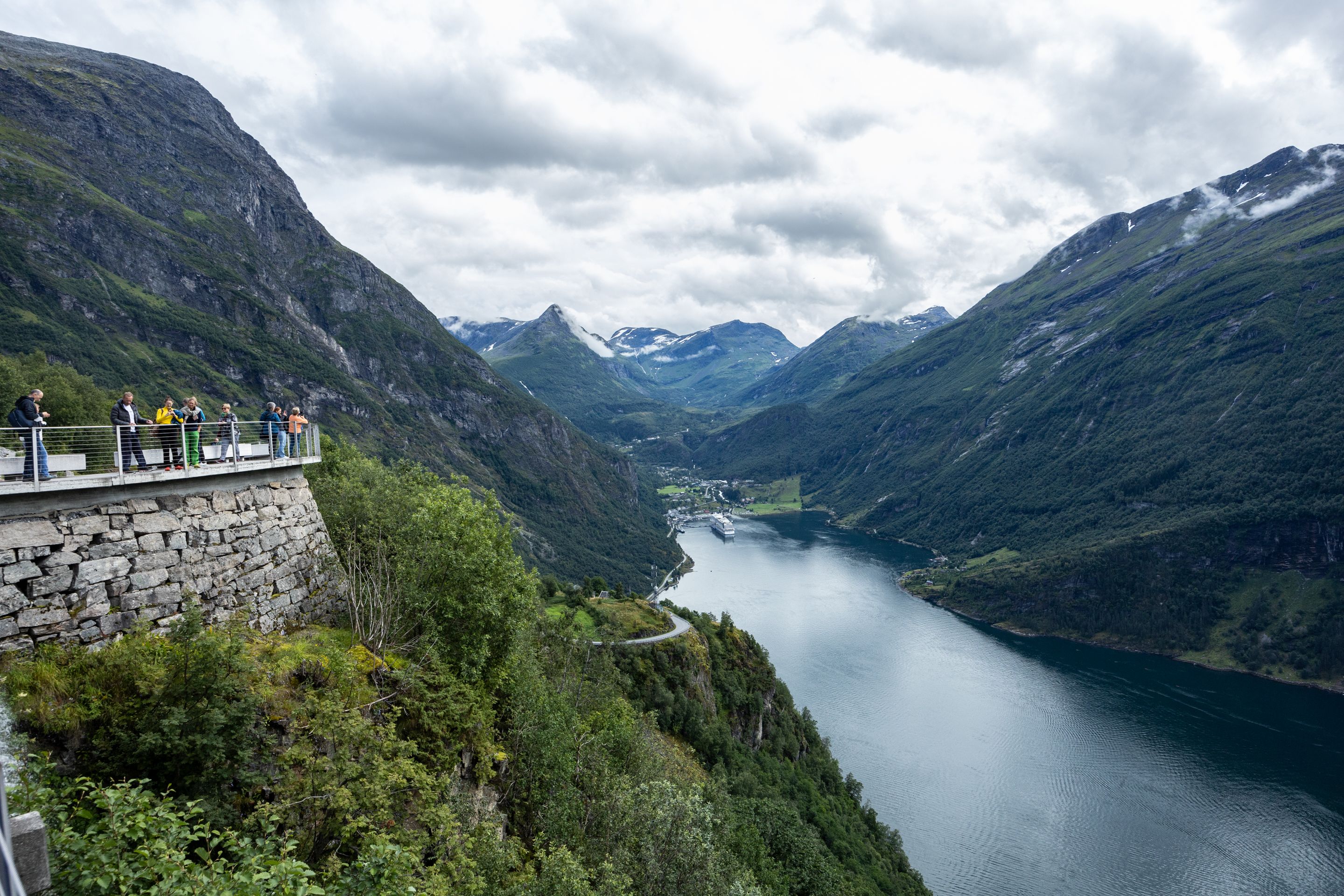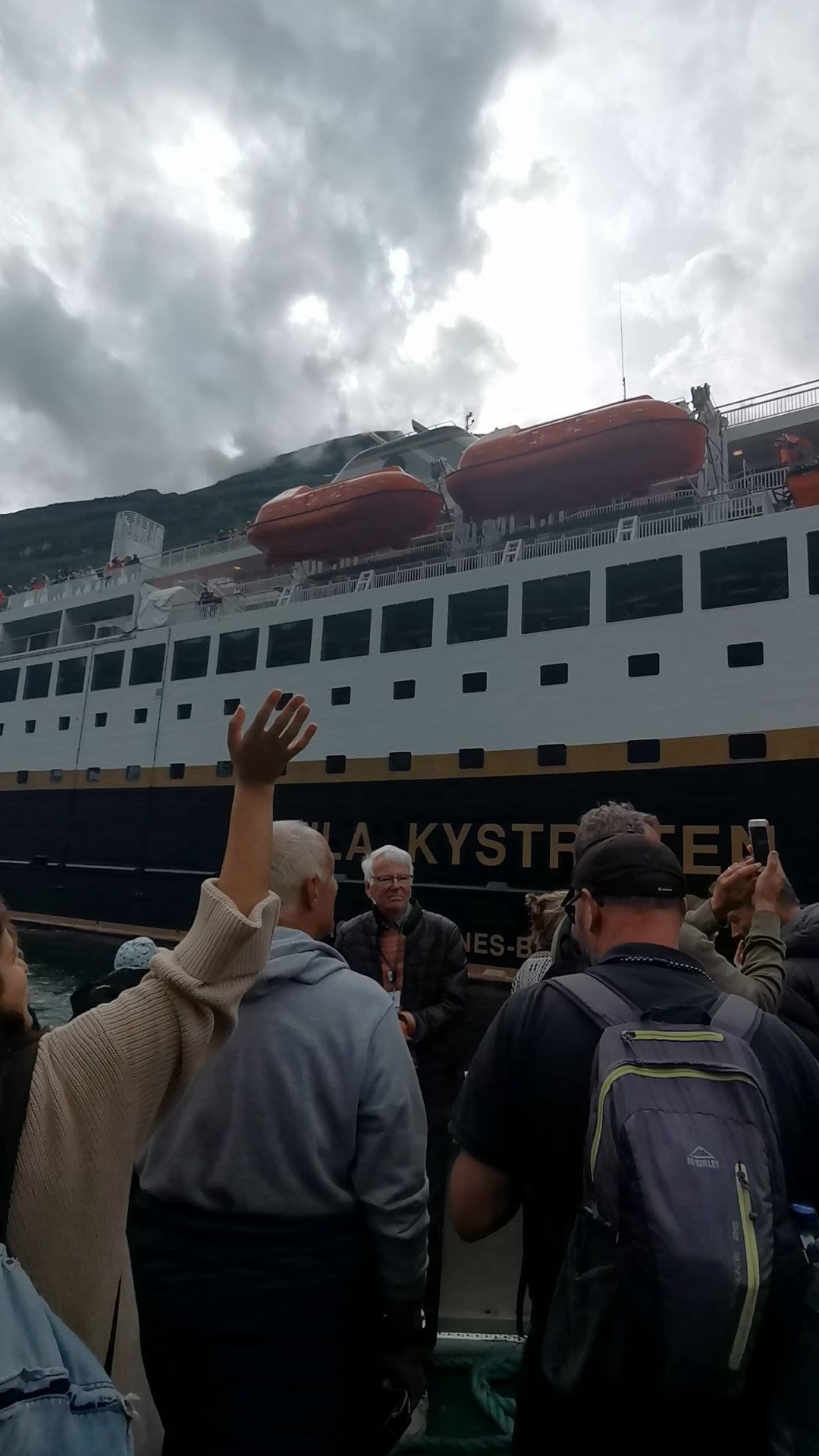Geiranger and
Trollstigen

Who would have thought that a bus tour could be this interesting?
Text: Josefine Spiro

The Havila Capella doesn’t dock at the quay in Geiranger; instead, we transfer to a passenger ferry that brings us ashore.
We gather on the deck of the ferry and wave Havila Capella goodbye.

She seems dwarfed by her neighbor – a German cruse giant – waiting for its guests, in this small, quiet harbor.
From the wharf, we board awaiting buses for the start of a guided day tour that will introduce us to some of the most spectacular scenery on Norway’s northwestern coast. Ahead of us, we have an many-our drive, with photo and sightseeing stops along the way. It will include two different car ferries across the fjords.
Because there’s a large number of Italian visitors on this cruise, Havila Voyages has reserved a bus with an Italian guide for them so they don’t miss a word along the trip.
The rest of us board a bus with a guide who turns out to be a smiling, young American, Dominic Arnosti.

He will be doing the guiding in both English and German – which he speaks fluently. I ask him what brought him to Norway.
“I’ve always wanted to come to Norway for work. Becoming a guide made it possible”, he says.
His enthusiasm is obvious. We sit back, ready to enjoy the day. Our guided journey will last for many hours, ending in the town of Molde, where we will have dinner at a hotel restaurant before boarding the Havila Capella once more.
Geiranger to Ørnesvingen
(Eagle Turn)
The bus winds its way up on the mountain route. Up, up, we go, around nine hair-raising hairpin curves, each with its own name and dramatic view.
On our way up, I spot two tiny huts built on the plateau of a cliff sticking out of the mountain wall. It’s hard to imagine who (or how?) anyone could live there, but the view alone is worth the effort.
We stop at the last hairpin curve: “Ornesvingen” (Eagle Turn).
It’s the highest, most breathtaking of all. From here, we can see the entire Geirangerfjord as well as the famous Seven Sisters waterfalls that pour out of sheer rock and tumble hundreds of feet far below.

That's worth a selfie...
Ørnesvingen to Gudbrandsjuvet
In Gudbrandsjuvet, we stop at a visitors’ center next to a narrow gorge to view the Valldøla river. For thousands of years, the river has shaped a whole system of rock formations and potholes that can be seen from viewing platforms.
I’m about to make my way to one of them when I see Dominic and stop to complement him on his collection of amusing facts about Norway that make the tourists laugh.
“In private, I’m actually more of an introvert, but I enjoy being a guide and feel comfortable in the role,” he replies.
His comment makes me smile as I rush over to the gorge to snap a photo of the waterfall splashing into the ice blue water.

Gudbrandsjuvet til Trollveggen
We continue up into the mountain road, passing streams, small rivers with waterfalls and wooden houses having quaint green turf roofs. Dominic explains that these roofs are an ancient Norwegian tradition going back to pre-historic times. The grass turf kept the houses warm and dry during the long and cold winters.
Sod, or turf, roofs were the most common type of roof on rural Norwegian and other Scandinavian countries’ houses until the late 18th century. Composed of strips of sod overlying a base of birch bark, these roofs kept homes warm and dry over the long winters. Examples of sod houses still exist in Norway and even in the U.S. Midwest, where generations of Norwegian immigrants settled.
We’re on the Trollstigen (the Troll Path), a serpentine mountain road and pass open only in the summer. The Trollstigen itself is not particularly long, but the mountain pass continues all the way to the small village of Valldalen – known for its strawberries.
“There are reindeer up here, and occasionally you can see muskrats,” Dominic says. All we see at the moment, however, are some lazy sheep, resting along the roadside.
At a steep incline of 10% and eleven hair-raising hairpin bends, the Trollveggen reaches an elevation of 850m (2,790ft) above sea level.
Right now, fog is covering everything.
When we step outside the bus to visit the highest viewpoint (Trollstigplataet) at 200m (650ft) above the road, the view is white as the snow.
But the tourists are not disappointed. This strange fog, and its magical effect on the landscape, may just be as satisfying as on a sunny day.
“We will be able to see more on the way down,” Dominic believes. Therefore, we limit the sightseeing stop to 15 minutes, which quickly extends to 25 because some of the passengers struggle to make it back in time. It doesn’t matter. We have enough time to catch our next ferry.
We don't see much more of the Troll Path further down the road, but the scenery is beautiful nevertheless. Do you see the bridge in the middle of the picture?
On our way down to the foot of Trollveggen, we pass some amusing troll sculptures including a three-headed creature, one with eyes that glow in the dark, another on a motorcycle, and a fourth one carrying an ice cream cone.
Trollveggen
There’s no way to miss it. At 1,000 m, Trollveggen is the highest rock wall in Northern Europe.

Trollveggen in Romsdalen.
Trollveggen in Romsdalen.
Though it’s been there for ages; it wasn’t until 1965 that rock climbers succeeded to reach the top. Unbelievable as it sounds, two teams – one Norwegian, the other British – achieved it one day apart.
The story of conquering the massive Trollveggen (The Troll Wall) is an amazing one. By sheer coincidence, Norwegian and British teams, both consisting of four young men, would try their hand at Trolveggen at the very same time. In the media, it was portrayed as a race, but in reality, the two teams knew nothing about each other before meeting on the train station in Oslo, on their way to the Wall. On their way, they exchanged information and helped each other to prepare for the big challenge.
The Norwegian team reached the top in 15 days of climbing. The British mastered the same feat the following day. Since then, the wall has been successfully climbed many times, but the first accent has gone down in the history books.
We park at the Trollveggen visitor's center.
On the lawn near the entrance, there is a small, old-fashioned police car. It's not accidental.
For a long time, police cars were parked at the foot of the rock wall, ready to arrest those who tried to bring a parachute with them up the mountain.
The massive wall has attracted base jumpers for years, but the sport has been prohibited there since 1986, due to the many accidents. It’s the only mountain in Europe with such a ban.
At the visitors center we’re served drinks and a slice of fresh apple cake, and we have the opportunity to watch an exciting documentary film about the dramatic first ascents of Trollveggen and base jumps from the top. Some of us visit the little shop before returning to the bus and heading for our final stop at Molde, a stretch that will include two ferries.
There we will meet up again with the Havila Capella – after a buffet dinner at the Hotel Alexandra Molde (where I will meet a nice couple from Germany who tell me the story of how a birthday present brought them to Norway and the Havila Capella – and, according to these seasoned travelers, the best trip ever).
To be continued.
Click here to read about Havila Voyages' excursion to Geiranger and Trollveggen.


